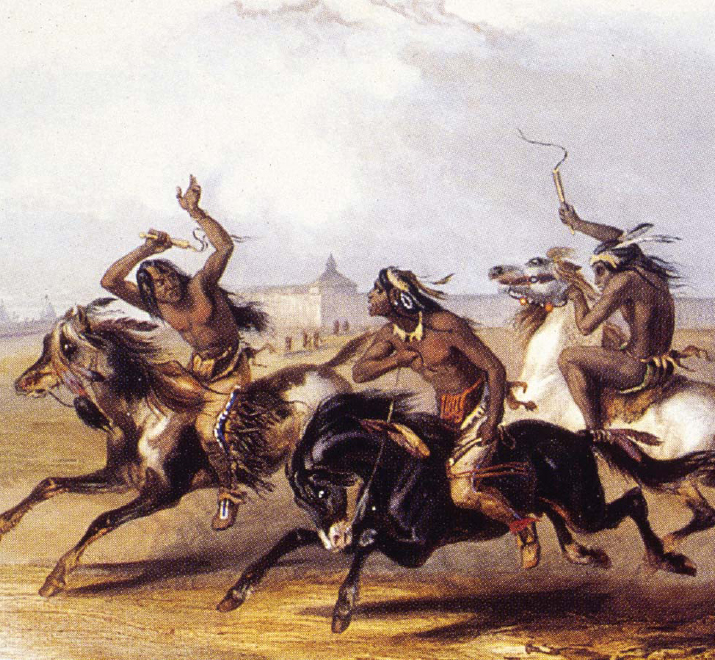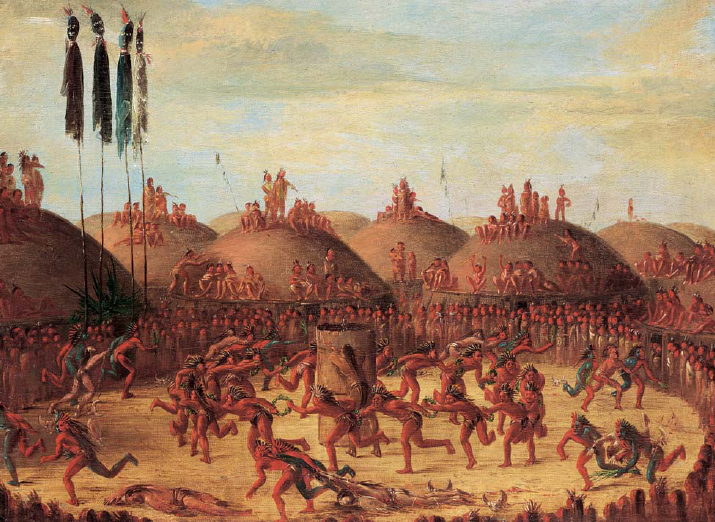
Native Americans, like highly skilled riders everywhere, enjoyed a good horse race.
Although guessing games were popular in the North, generally only a few people played them at one time. In the Southwest, however, guessing games were a spectator sport. In New Mexico, the Zuñi games were so popular that people climbed onto rooftops to watch them. Different clans often challenged one another. Everyone came out to watch and cheer the players on. In one game, a stone ball would be hidden in one of four tubes. Players from opposite clans would have to guess which tube it was in. Correct guesses scored the clan points. This was a popular game for gamblers. Many valuable items—necklaces, embroidery, silver, and livestock—were won and lost on this game. Games usually lasted well into the night.
Another popular game is cat’s cradle. This game is still played by children today. Players make patterns out of string wrapped around their fingers. This was popular throughout Native America, but particularly in the Southwest. The Navajo, Hopi, and Zuñi knew several patterns for the string. The Zuñi called the game pishkappoa, which means “netted shield.” Legend says that the Zuñi creator, Spider Grandmother, taught the game to her twin sons, the war gods.
Spider Grandmother’s web also figures in the Zuñi version of the hoop and pole game. The netted hoop represented the magical spider web woven by Spider Grandmother. It was played with corncob darts, but was otherwise much like the northern version.
The hoop and pole game isn’t the only game that was popular on both sides of the Great Plains. Shinny was much like the Southeast’s double ball. As with double ball, it was women who primarily played shinny, using curved sticks and buckskin balls. Some games were played for fun, but others were ceremonial. During a ceremonial game, the ball was sometimes filled with seeds. If it burst open during the game, the seeds would scatter around the field. This was a sign of a good harvest.
Another transplanted game was shuttlecock. The Zuñi called their game po-ke-an, and it was somewhat different from the northern variety. One of the differences was the shuttlecock itself. In the Southwest, it was made from corn husks and feathers, rather than wood. Also, no one used paddles in the Southwest. Instead, they hit the shuttlecock with their hands. Even the players were different. In the North, it was mostly a child’s game. In the Southwest, grown men often played po-ke-an.
Po-ke-an also had different rules. A player would pick a number. He would bet that he could hit the shuttlecock that number of times without it touching the ground. He would bat the shuttlecock into the air and use only one hand to keep it up. If he could hit the shuttlecock the right number of times, he would win the bet. If not, the other player would get a chance to match him. Whoever made it to the number first won the bet.

Native Americans, like highly skilled riders everywhere, enjoyed a good horse race.

This ceremonial race of the Mandan tribe involved circling around a barrel-like object, called the “big canoe,” in the center of the village.
The shuttlecock game emphasized balance and control. The Hopi people played an archery game that stressed aim. The game played like a modern game of horseshoes. Before the game, players would build two slopes facing each other, about 200 feet apart. Each slope had a target for players to shoot at. The archer who came closest could take the first shot at the next target.
One Hopi arrow game didn’t involve bows. Players would throw arrows to the ground instead. Each player would try to get the feathered back of his arrow, called the fletching, to lie across the other arrows. Whoever did could keep both arrows. This game was popular with Apache and Tewa children. Southwestern children also enjoyed playing with a wide variety of toys, including dolls, bean shooters, tops, hoops, darts, and small animals made from clay.
There was one type of game that was played all over the Southwest and nowhere else. This game was a ball race. It was a footrace, but with a twist. Teams of four or five players kicked objects from the starting point to the finish line. Often, the race would run through a set course, finally returning to the starting point. The course was sometimes 30 miles long.
Different tribes kicked different objects. The Pima and Tewa Indians used a stone ball. For the Opata, Mohave, and Yuma, the ball was made of wood. The Hopi used two cubes of hair stuck together. Some tribes used rings or wooden cylinders. The Bannock people even used an inflated cow bladder.
Whatever the object, it could not be touched by a racer’s hands. Also, the race was run barefoot. If the ball was kicked into briars or sharp rocks, runners had to use their feet to get it back. It was obviously important to be careful. Any foot injuries would affect a player’s running speed.
There were almost as many reasons to hold a ball race as there were objects to kick. The Zuñi ran the races after planting time. When the race was over, they would sacrifice the kicking sticks to their war god. The Keres people of New Mexico ran the race from March to May in order to bring rain. After some races, the objects would be buried to make the plants grow. Almost everywhere, people bet on the races. The bets could include money, bracelets, blankets, or livestock. Runners did not win prizes, but they would sometimes get a share of their friends’ bets.
The most unusual game played in the Southwest was sometimes called the gallop race. It also had a more descriptive name: the chicken pull. At the start of some games, a rooster would be suspended from a pole. Another way to start was to bury the rooster in the ground so that only its head was showing.
BATTLE OF THE SEXES
One of the few contests in which men and women competed with each other was the rabbit hunt. Several southwestern tribes practiced this. A man and a woman would pair up and go hunting for rabbits together. If the woman shot the rabbit before the man did, they would switch clothes.
If this happened, the man had to shoot the next rabbit they saw. If the woman shot the next one instead, the man would have to bring her firewood.
At the beginning of the race, a player on horseback would grab the chicken, riding off with it. Other riders followed him. Everyone grabbed for the chicken. The game could get violent. Heedless of danger, players groped for the chicken while on horseback. Eventually, the chicken would be pulled apart. Players chased anyone who got a piece. They fought for the chicken as they all rode toward the finish line. The player who first reached the finish line with a piece of chicken won. Chicken pull was sometimes played on foot. This made it a bit safer, although the fights for chicken pieces were every bit as fierce. §

This page from an Aztec codex, or manuscript book, depicts the dice game called patolli. The game was a favorite of serious gamblers: some even risked being sold into slavery if they lost!